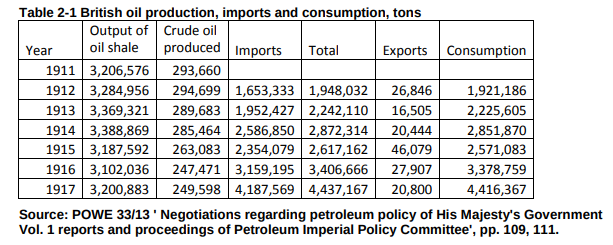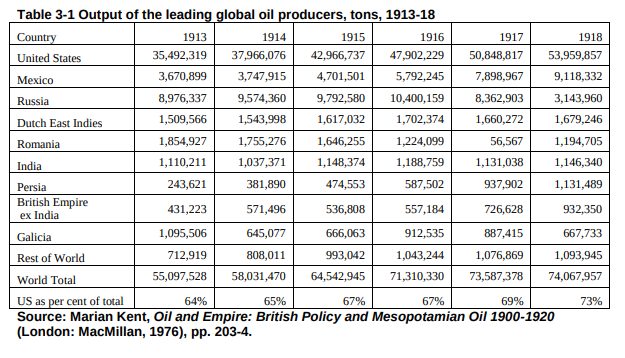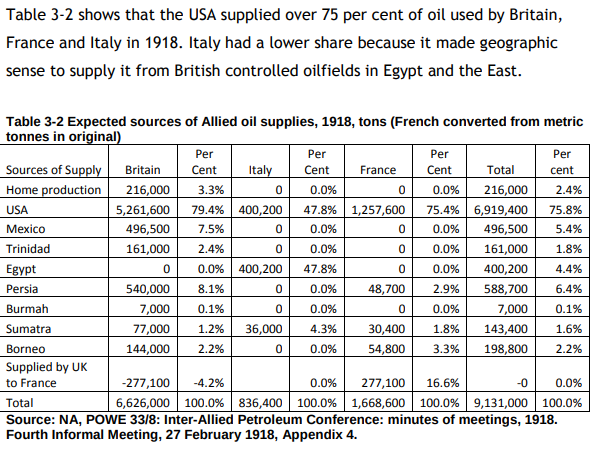Restrictions on oil imports affected food supplies in two ways. The first was that importing oil in double bottoms of cargo ships meant that ships not designed to carry oil could transport it. It did not increase the cargo capacity of the ship so there was a trade off between oil and other goods such as food. On 13 August Maclay told the First Lord of the Admiralty and Hankey that imports from the USA and Canada had fallen by about 1,250,000 tons per annum because of the need to carry oil in the double bottoms of liners and cargo ships. To replace losses 480,000 tons of tankers were being constructed annually, a fifth of the total merchant ship construction programme. The absence of the cargo ships that otherwise would have been built meant a fall of 1,750,000 tons of imports over twelve months. These figures were for naval oil only: another 250,000 of capacity must be allocated to double bottom imports to maintain commercial stocks and 240,000 tons of construction used to replace sunk commercial tankers.
The shortage of oil also impacted domestic food production because of attempts to increase output by replacing farm animals with motorised tractors. On 17 July Rowland Prothero, the President of the Board of Agriculture, wrote to Long regarding a letter sent by Cadman to the Board of Agriculture asking it to consider cutting its demands for petrol for tractors. Prothero wanted to help as much as possible but could not do so without reducing a ploughing programme that had been approved by the Cabinet. If insufficient petrol was available to carry out this out then he felt that it was up to the Cabinet rather than himself to reconsider the situation.254 Long explained that Cadman was acting on his authority; he was responsible to the Cabinet for all issues regarding oil.
In November Prothero warned the War Cabinet that insufficient fuel had allocated to the motor tractors ordered as part of a programme to increase agricultural output in England and Wales. He argued that food production should be given the same status as the armed forces and munitions output, giving it priority over other civilian and industrial uses. The Cabinet should make sure that more oil was imported and that enough of it was allocated to food production. Otherwise the part of the ploughing programme to be carried out by motor tractors would have to be abandoned. In that case the Cabinet must give the order or the Board of Agriculture would lose all credibility with farmers.256 Long explained that oil stocks still were dangerously low despite the importation of 100,000 tons per month in double bottoms. Doing so reduced the imports of food and other essentials so all new tankers would have to be used to replace the use of double bottoms. The Ministry of Shipping estimated that overall imports must be reduced by 8,000,000 tons per annum (666,000 tons per month), showing that the use of double bottoms must end as soon as a safety margin of oil stocks was secured. Demand for petroleum products from the Armed Forces was rising; almost all new warships burnt oil. The required level of naval stocks was rising each month. Prothero's requests placed demands on tanker tonnage that Long would do his 'utmost to meet, but which it is impossible to guarantee in the existing conditions of the Admiralty and War Office stocks.'257 Adoption of Prothero's proposal to treat agriculture the same as the armed forces would contradict the Cabinet's ruling, and would return to the situation that the current structure was intended to avoid. Shipping resources were already operating at maximum effort.
In December Maclay told the Petroleum Committee that Britain was 'faced with a very serious deficit in the tonnage now required to be allotted to Government services. The wheat position is particularly grave.'258 By the end of January, wheat stocks would be only 15-16 weeks demand, a very low level since half was held by the farmers. Wheat was available in the USA; the problem was finding ships to transport it. Maclay said there was a shortage of 40 ships, and it was 'of the utmost importance that every possible step be taken to reduce this deficit.'259 He suggested that half the deficit could be covered by abandoning the use of double bottoms for oil for a month. J. A. Salter, the Director of Shipping Requisition, attended the 12th meeting of the committee on 12 December 1917. He explained that the main problem was the failure of the French and Italian harvests, meaning that imports had to be diverted from Britain to those countries. The meeting concluded that a telegram should be sent to Sir Frederick Black in New York urging that the Americans release more tonnage for the North Atlantic route. Stopping use of double bottoms was discussed. Long insisted that naval fuel had to be prioritised.


